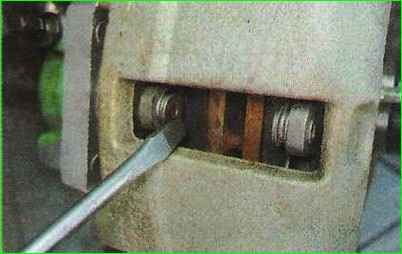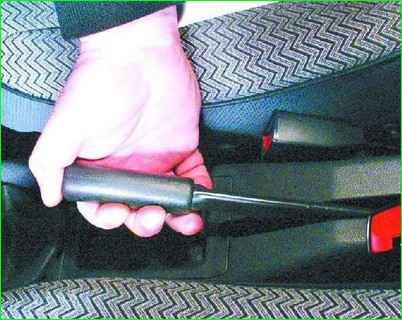Checking the efficiency of the brake system
In accordance with paragraph 1.1 of the "List of malfunctions and conditions under which the operation of vehicles is prohibited", the braking distance of the car with a single press of the brake pedal from a speed of 40 km / h should be no more than 12.2 m
The test is carried out on a dry, clean, horizontal section of the road with concrete or asphalt pavement.
The car's brake system must be sealed.
The brake fluid level in the reservoir must be at the MAX mark.
Accelerate the car to 40 km / h.
Press the brake pedal all the way down, locking the wheels, and hold it in this position until the car comes to a complete stop.
Measure the braking distance of the car with a tape measure. If the length is more than 12.2 m, the braking system is not effective enough.
To eliminate the influence of side effects, the braking distance is checked by accelerating the car in two opposite directions on the same section.
Checking the brake fluid level
The brake fluid level is checked periodically: daily during vehicle operation, during each maintenance, after bleeding the brake system hydraulic drive and replacing the brake fluid, when the control lamp on the instrument panel lights up, signaling an insufficient level of brake fluid in the brake master cylinder reservoir.
Prepare the car for work.
Use a rag to remove dirt from the brake master cylinder reservoir.
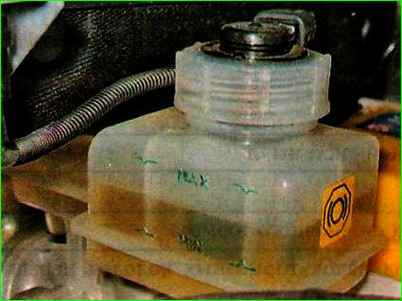
Visually check the brake fluid level in the reservoir. It should be between the MIN and MAX marks on the reservoir body.
Check the degree of wear of the brake pads of the front and rear brake mechanisms.
If the wear of the brake pads is within the normal range, and the fluid level in the reservoir is below the MIN mark, then disconnect the wire harness tip from the brake fluid emergency level sensor, unscrew and remove the reservoir cap.
Add new brake fluid to the reservoir up to the MAX mark (when installing the reservoir cap, the sensor float will be immersed in the liquid and its level will increase).
Close the reservoir cap tightly.
Connect the wire harness block to the sensor connector.
Check the operation of the brake fluid emergency level sensor: with the ignition on, press on the rubber cover from above tank.
If the sensor is working properly, the indicator light on the instrument panel will come on.
Checking the wear of the brake pads
Check the wear of the front brake pads in the following order.
Place the car on an inspection ditch.
Remove the front wheels.
When checking the pads of the left brake mechanism, turn the steering wheel completely to the left, and when checking the pads of the right brake mechanism, turn it to the right.
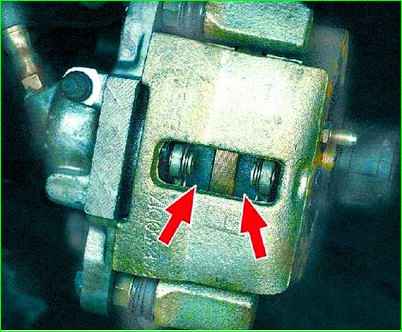
We visually determine the thickness of the brake pad linings through the inspection hole in the sliding bracket of the caliper.
If the thickness of the lining of at least one pad is less than 1.5 mm, we change all the brake pads of the brake mechanisms of the right and left wheels.
At the same time, we check the mobility of the pistons of the brake cylinders.
If the piston is stuck, replace the cylinder.
To check the degree of wear of the brake pads of the rear brake mechanisms, you will need flashlight.
Prepare the car for work.
Use a slotted screwdriver to remove the rubber plug of the inspection hole in the support shield of the rear wheel brake mechanism.
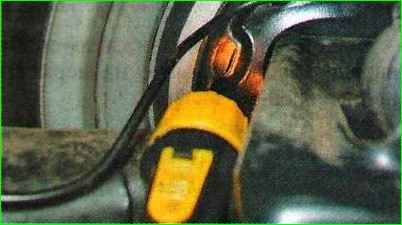
Illuminate the inspection hole with a flashlight.
If the thickness of the brake pad lining "A" is less than 1.5 mm, change all the brake pads of the brake mechanisms of the right and left wheels.
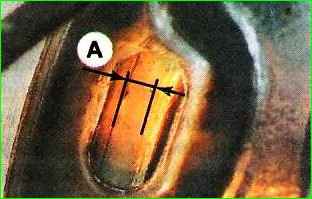
Install the plug in place.
Checking and brake booster
Prepare the car for work.
With the engine off, press the brake pedal several times until the hissing in the brake booster stops.
Press the brake pedal and hold it down.
Without releasing the pedal, start the engine.
If the pedal moves down a little immediately after starting the engine, the brake booster is working properly.
Otherwise, check the integrity of the vacuum supply hose to the vacuum booster, the tightness of its connection to the inlet receiver and the booster check valve pipe.
If the hose is in good condition and is tightly connected, the vacuum booster is faulty.
Checking the free travel of the pedal
The free travel of the brake pedal is the travel pedal from its upper position until the brake mechanisms begin to operate. It should be 3-5 mm.
You will need a ruler or tape measure to do the job.
Prepare the car for the job.
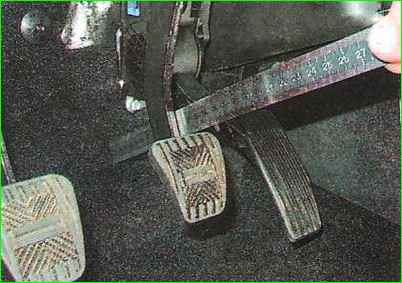
Place a ruler or tape measure near the pedal and measure the distance from the floor to the outer surface of the brake pedal.
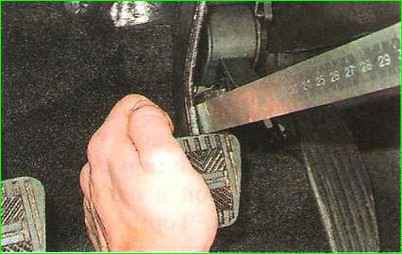
Pressing the pedal with your hand, lower it until you feel an increase in resistance to the pedal movement.
Repeat the measurements. The difference between the obtained values is used to determine the free travel.
The presence of free travel of the brake pedal ensures that after braking stops, the pistons of the master cylinder will return to their original position, and as a result, there will be no excess pressure left in the brake hydraulic drive.
When the brake light switch is installed so that it limits the backward travel of the brake pedal, the brake system will be able to maintain pressure at which the brake pads will constantly brake.
If the free travel of the brake pedal is less than the optimal value, it is necessary to adjust the position of the brake light switch.
Increased free travel of the brake pedal may be caused by play in the drive mechanism. Worn parts must be replaced.
The presence of air in the brake hydraulic drive or a malfunction of the master cylinder may also be the cause of the malfunction. The detected malfunction must be eliminated.
Checking the parking brake
During vehicle operation, due to wear of the rear brake shoe linings and stretching of the drive cables, it is periodically necessary to adjust the travel of the parking brake lever.
The travel of the parking brake lever should be 2-4 clicks. In this case, the braking system must reliably hold the equipped vehicle on a slope of 23%.
If this is not the case, we check the condition of the parking brake system and, if necessary, adjust it and replace worn or damaged parts, after which we repeat the check.






